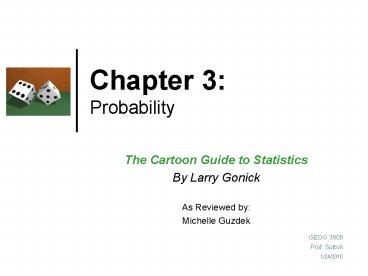Chapter 3: Probability - PowerPoint PPT Presentation
1 / 23
Title:
Chapter 3: Probability
Description:
Chapter 3: Probability The Cartoon Guide to Statistics By Larry Gonick As Reviewed by: Michelle Guzdek GEOG 3000 Prof. Sutton It all started with gambling – PowerPoint PPT presentation
Number of Views:108
Avg rating:3.0/5.0
Title: Chapter 3: Probability
1
Chapter 3Probability
- The Cartoon Guide to Statistics
- By Larry Gonick
- As Reviewed by
- Michelle Guzdek
GEOG 3000 Prof. Sutton
2
It all started with gambling
- No one knows when it started, but it at least
goes as far back as Ancient Egypt. - The Roman Emperor Cladius
- (10BC 54 AD) wrote the first
- book on gambling.
- Dice grew popular in the
- Middle Ages.
3
Basic Definitions
- Random Experiment the process of observing the
outcome of a chance event. - Elementary Outcome all possible results of the
random experiment. - Sample Space the set or collection of all the
elementary outcomes.
4
Coin Toss Example
- The random experiment consists of recording the
outcome. - The elementary outcomes are heads and tails.
- The sample space is
- the set written as H,T.
5
Sample Space
For a single die
For a pair of dice
6
Probability
- Probability is a numerical weight assigned to a
possible outcome. - In a fair game of heads and tails, the outcomes
are equally likely so probability is .5 for both. - P(H) P(T) .5
- For two dice, there are 36 elementary outcomes
all equally likely. - P(BLACK 5, WHITE 2) (1/6)(1/6) 1/36
7
Probability Histogram
8
Probability Histogram
9
What if
- What if things were not equal and a gambler
throws loaded die? - Now P(1) .25, and the remaining probabilities
must equal 1 - .25 .75. - It 2,3,4,5, and 6 are equally likely to occur the
probability of each is - .75/5 .15
P(x) .25 .15 .15 .15 .15 .15
10
Random Experiment
- Probabilities are never zero.
- A probability of zero means it cannot happen.
- Less than zero would be meaningless.
- Therefore
- P(Oi) 0
- If an event is certain to happen we assign
probability of 1. - Combine these two and you have the Characteristic
Properties of Probability - P(Oi) 0
- P(O1) P(O2) P(On) 1
11
Approaches to Probability
- Classical Probability
- Based on gambling ideas.
- Assumption is the game is fair and all elementary
outcomes have the same probability. - Relative Frequency
- When an experiment can be repeated, then an
events probability is the proportion of times
the event occurs in the long run. - Personal (Subjective) Probability
- Lifes events are not repeatable.
- An individuals personal assessment of an
outcomes likelihood. For example, betting on a
horse.
12
Modeled Probability vs. Relative Frequency
13
Basic Operations
- An EVENT is a set of elementary outcomes.
- The probability of an event is the sum of the
probabilities of the elementary outcomes in the
set. - You can combine events to make other events,
using logical operations. - AND, OR or NOT
14
Event Dice Add to 7
15
Calculate the events
16
Answer
17
Calculate Probability
18
Answer
19
Addition Rule
- Mutually exclusive not overlap
- P(E OR F) P(E) P(F)
- Overlap of elementary outcomes
- P(E OR F) P(E) P(F) P(E AND F)
- When P(NOT E) is easier to compute use
subtraction rule. - P(E) 1 P(NOT E)
20
Conditional Probability
- The probability of A, given C
- P(AC) P(E AND F)/P(F)
- When E and F are mutually exclusive
- P(EF) 0, once F has occurred E is impossible
- Rearranging the definition get multiplication
rule - P(E AND F) P(EF)P(F)
21
Independence
- Two events E and F are independent of each other
if the occurrence of one had no influence on the
probability of the other. - P(E AND F) P(E)P(F)
22
Bayes Theorem
23
References
- DiFranco, Steven. Chapter 3 Probability
Distributions, 2009. http//www.difranco.net/qmb2
100/Lecture_notes/Chapter_3/ch03hb.htm - Hajek, Alan. Interpretations of Probability,
2009. - http//plato.stanford.edu/entries/probability-in
terpret/ - Joyce, James. Bayes Theorem, 2003.
http//plato.stanford.edu/entries/bayes-theorem/
- Khan Academy (YouTube Username khanacademy).
Probability (part 1), 2008. http//www.youtube.co
m/watch?v3ER8OkqBdpE - Khan Academy (YouTube Username khanacademy).
Probability (part 5), 2008. http//www.youtube.co
m/watch?v2XToWi9j0Tk - Spaniel, William (YouTube Username
JimBobJenkins). Game Theory 101 Basic
Probability Rules, 2009. http//www.youtube.com/w
atch?vdFSWW6QTVp0 - Waner, Stefan and Steven Constanoble. 7.3
Probability and Probability Models, 2009.
http//www.zweigmedia.com/RealWorld/tutorialsf15e
/frames7_3.html - Interactive quizzes































